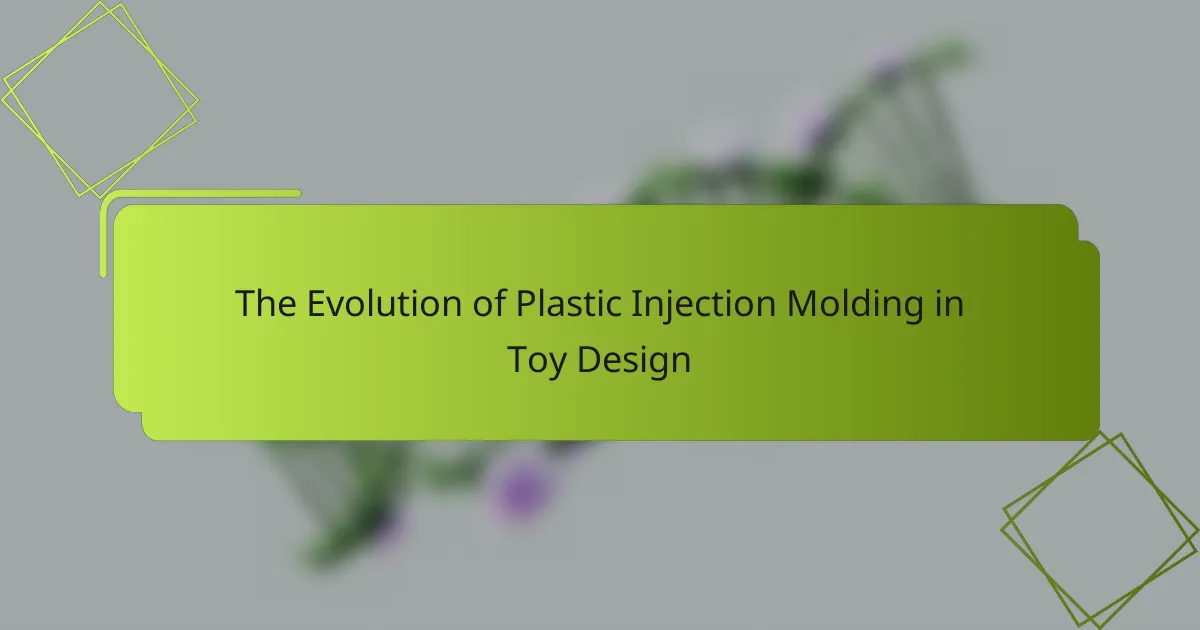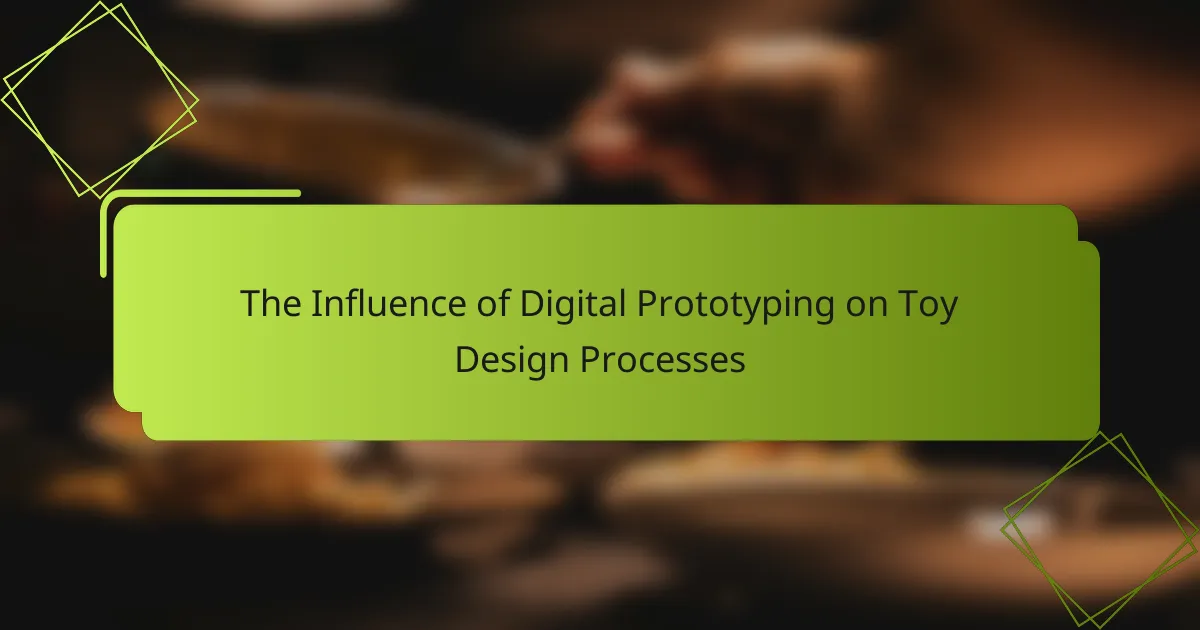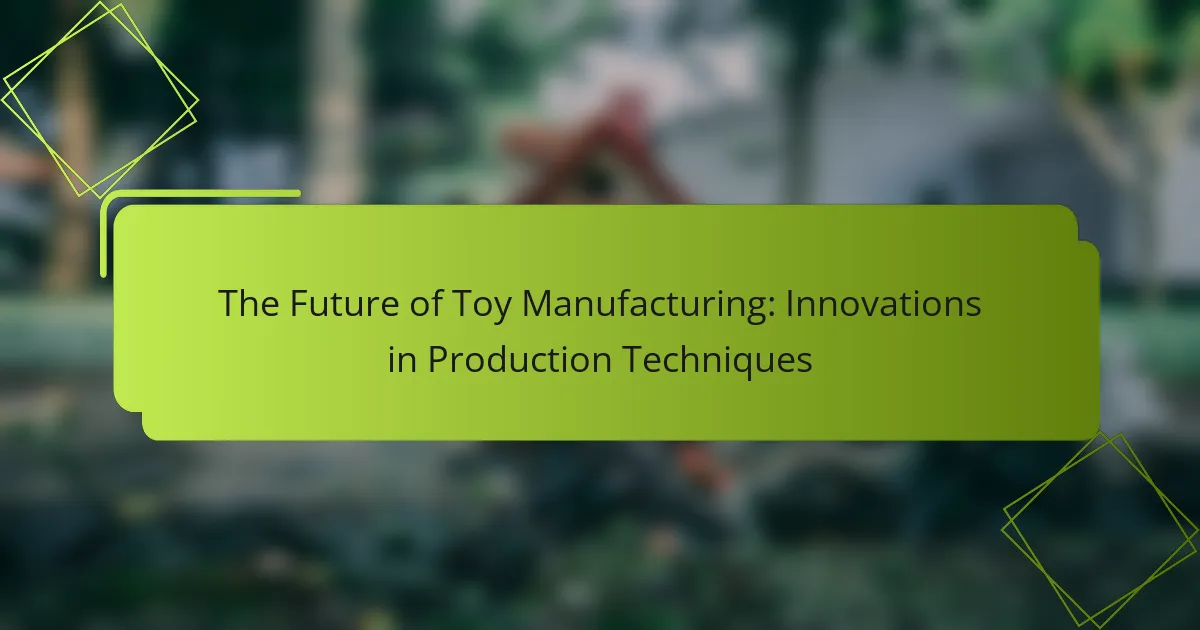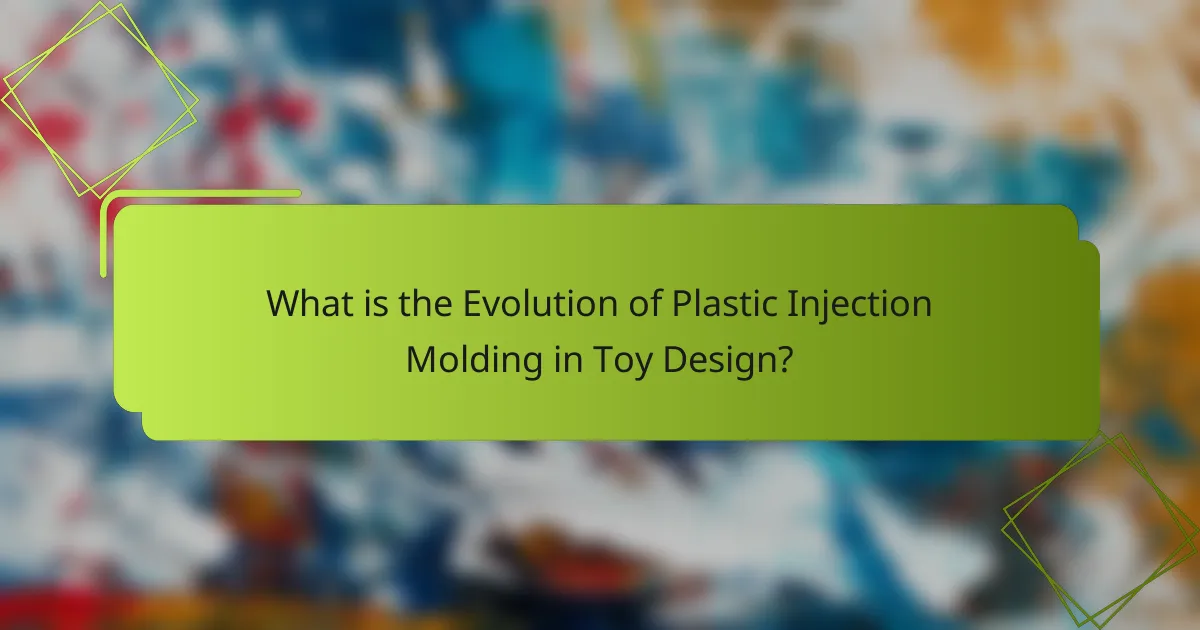
What is the Evolution of Plastic Injection Molding in Toy Design?
Plastic injection molding has significantly evolved in toy design since its inception. Initially, in the 1930s, this process allowed for mass production of simple plastic shapes. Early toys were often made from bakelite and featured basic designs. The introduction of nylon in the 1940s expanded possibilities, enabling more durable and flexible toys.
By the 1960s, advancements in technology led to more intricate designs and vibrant colors. The development of computer-aided design (CAD) in the 1980s further enhanced precision in toy manufacturing. Today, modern plastic injection molding allows for complex, customizable designs and sustainable materials. This evolution has transformed toy design into a sophisticated industry focused on creativity and safety.
How did plastic injection molding first emerge in toy design?
Plastic injection molding first emerged in toy design in the early 20th century. This manufacturing process allowed for the mass production of intricate plastic toys. The first patent for an injection molding machine was granted to John Wesley Hyatt in 1872. This innovation laid the groundwork for future developments in toy manufacturing. By the 1940s, companies began using plastic injection molding for toy production. The process enabled the creation of complex shapes and designs that were previously difficult to achieve. This led to a surge in the variety and popularity of plastic toys. The introduction of new plastics like ABS and polystyrene further enhanced the capabilities of injection molding in toy design.
What were the initial materials and techniques used in early toy manufacturing?
Early toy manufacturing primarily utilized wood, metal, and cloth. These materials were abundant and easy to work with in historical contexts. Wood was shaped into various forms, such as dolls and vehicles. Metal was often used for toy soldiers and miniature models. Cloth was employed for stuffed toys and puppets. Techniques included hand-carving, sewing, and metal casting. These methods allowed artisans to create detailed and functional toys. Historical artifacts show that these initial materials laid the groundwork for future advancements in toy design.
How did technological advancements influence early plastic injection molding?
Technological advancements significantly influenced early plastic injection molding by improving efficiency and precision. The introduction of electric motors in the 1950s replaced steam power, allowing for more consistent temperature control. This change led to better material flow and reduced cycle times. Additionally, the development of thermoplastics expanded the range of moldable materials. Innovations in mold design, such as multi-cavity molds, increased production rates. Enhanced computer-aided design (CAD) tools allowed for more complex shapes and improved mold accuracy. These advancements collectively transformed plastic injection molding into a viable manufacturing process for toys, enabling mass production and innovation in design.
What are the key milestones in the evolution of plastic injection molding for toys?
The key milestones in the evolution of plastic injection molding for toys include the introduction of the process in the 1870s. This innovation allowed for the mass production of plastic items. In the 1940s, the development of thermoplastics revolutionized toy manufacturing. The first plastic toys were produced during this period. In the 1960s, advancements in injection molding technology improved efficiency and design capabilities. The introduction of color and intricate designs became possible. The 1980s saw the rise of computer-aided design (CAD) in toy design. This technology allowed for more precise and creative toy designs. By the 2000s, sustainable practices began to influence plastic toy production. Manufacturers started using recycled materials and eco-friendly processes. These milestones highlight the significant advancements in plastic injection molding for toys over time.
What significant innovations shaped the development of this manufacturing process?
The significant innovations that shaped the development of plastic injection molding in toy design include the introduction of thermoplastics and advancements in machinery. Thermoplastics, such as ABS and polycarbonate, allowed for more durable and versatile toy designs. The development of hydraulic and electric injection molding machines improved precision and efficiency. Additionally, the implementation of computer-aided design (CAD) software facilitated complex design capabilities. The use of robotics in the manufacturing process increased automation and reduced labor costs. These innovations collectively enhanced production speed and quality in toy design.
How did market demands impact the evolution of toy design and production methods?
Market demands significantly influenced the evolution of toy design and production methods. As consumer preferences shifted towards more interactive and durable toys, manufacturers adapted their designs accordingly. The rise of plastic materials allowed for innovative shapes and colors, responding to children’s desires for visually appealing products.
In the 1950s, the introduction of plastic injection molding revolutionized production efficiency. This method enabled mass production of complex designs, meeting the increasing demand for affordable toys. Additionally, safety regulations prompted manufacturers to prioritize non-toxic materials and sturdy construction in their designs.
The popularity of licensed characters from movies and television shows also shaped toy design. Companies began creating toys that aligned with popular culture, ensuring higher sales. Market research became essential, guiding companies in understanding trends and preferences.
Overall, the interplay between market demands and production methods led to a dynamic evolution in toy design, characterized by innovation, safety, and alignment with consumer interests.
Why is plastic injection molding crucial in modern toy design?
Plastic injection molding is crucial in modern toy design because it allows for efficient mass production of complex shapes. This manufacturing process ensures consistency and precision in toy designs. It enables the creation of intricate details that enhance the aesthetic appeal of toys. Additionally, plastic injection molding reduces production costs by minimizing material waste. The speed of this process allows companies to bring new toys to market quickly. Historical data shows that over 90% of toys are made using plastic injection molding techniques. This statistic highlights its dominance in the industry. Moreover, the versatility of materials used in injection molding supports a wide range of toy types. Overall, plastic injection molding is essential for innovation and competitiveness in the toy market.
What advantages does plastic injection molding provide over other manufacturing methods?
Plastic injection molding offers several advantages over other manufacturing methods. It enables high production rates, making it efficient for mass production. The process allows for complex shapes and intricate designs that are difficult to achieve with other methods. Additionally, plastic injection molding produces minimal waste compared to subtractive manufacturing techniques. The method also ensures consistent quality and precision in the final products. Furthermore, it allows for a wide variety of materials to be used, enhancing versatility. The ability to easily automate the process leads to reduced labor costs. Lastly, the initial setup costs can be offset by the long-term savings in production efficiency.
How does this process improve the safety and durability of toys?
The process of plastic injection molding enhances the safety and durability of toys by ensuring precise manufacturing. This method allows for consistent production quality, reducing the likelihood of defects. Toys made through injection molding are less likely to break during use due to their uniform density and strength. The process also enables the use of non-toxic materials, which improves safety for children. Additionally, injection molding allows for complex designs that can include safety features, such as rounded edges and secure joints. According to the American Society for Testing and Materials, toys produced through this method meet rigorous safety standards. This combination of factors results in toys that are both safe and durable for prolonged use.
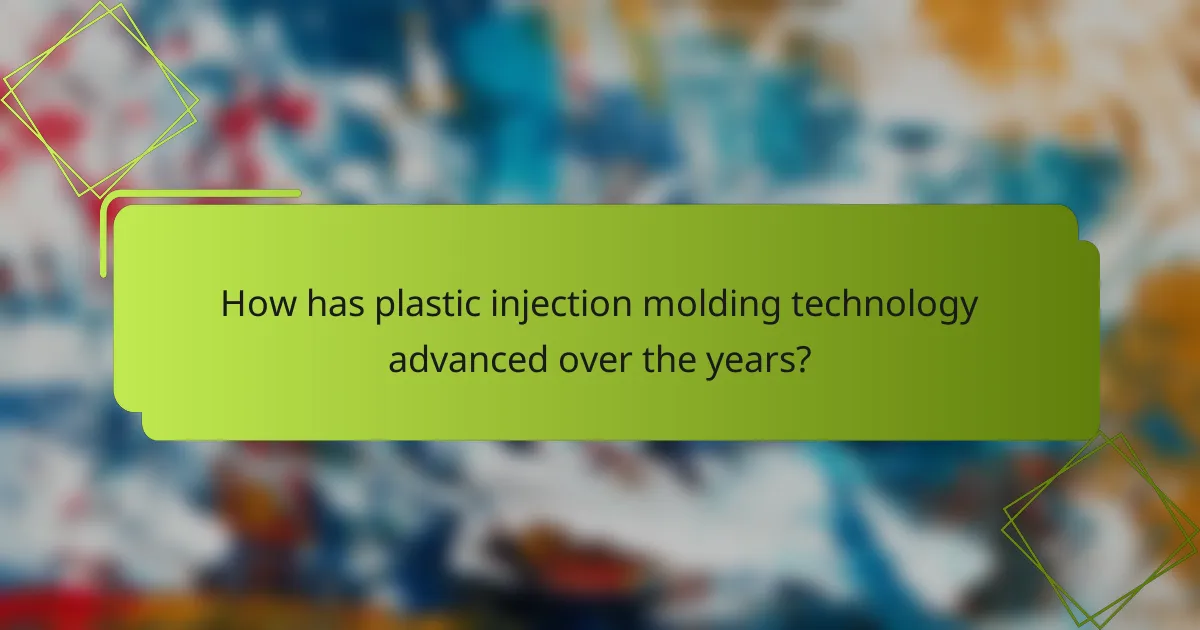
How has plastic injection molding technology advanced over the years?
Plastic injection molding technology has advanced significantly over the years. Innovations include the development of more efficient machines that reduce cycle times. Enhanced materials have improved the strength and flexibility of molded products. Advanced computer-aided design (CAD) software allows for more precise mold designs. Automation and robotics have streamlined production processes, increasing consistency and reducing labor costs. The introduction of multi-material injection molding enables the creation of complex parts with varying properties. Environmental considerations have led to the use of biodegradable plastics in molding processes. Continuous advancements in technology have made plastic injection molding more sustainable and cost-effective.
What modern technologies are now integrated into plastic injection molding?
Modern technologies integrated into plastic injection molding include automation, advanced robotics, and 3D printing. Automation enhances production efficiency by reducing manual intervention. Advanced robotics improve precision and consistency in the molding process. 3D printing allows for rapid prototyping and custom mold creation. These technologies enable faster turnaround times and lower production costs. Additionally, Industry 4.0 technologies, such as IoT and data analytics, optimize manufacturing processes. These advancements lead to better quality control and reduced waste. Together, these technologies revolutionize plastic injection molding, particularly in the toy design industry.
How do automation and robotics enhance the efficiency of toy production?
Automation and robotics significantly enhance the efficiency of toy production. They streamline processes by reducing manual labor and increasing production speed. Automated systems can operate continuously without fatigue, leading to higher output rates. Robotics improve precision in tasks such as assembly and painting, resulting in fewer defects. This technology also allows for more complex designs to be manufactured consistently. According to a study by the International Federation of Robotics, implementing automation can increase productivity by up to 30%. Furthermore, automated quality control systems ensure that products meet safety standards, reducing recalls and enhancing consumer trust.
What role does computer-aided design (CAD) play in modern toy manufacturing?
Computer-aided design (CAD) is essential in modern toy manufacturing. CAD streamlines the design process, allowing for precise modeling of toy components. It enhances creativity by enabling designers to visualize concepts in 3D. This technology reduces the time required for prototyping, leading to quicker production cycles. Additionally, CAD facilitates collaboration among teams, as designs can be easily shared and modified. The accuracy of CAD minimizes errors during manufacturing, ensuring high-quality final products. According to a study by the American Society of Mechanical Engineers, CAD can reduce design time by up to 30%. Therefore, CAD significantly impacts efficiency and innovation in toy manufacturing.
What environmental considerations are associated with plastic injection molding?
Plastic injection molding has several environmental considerations. The process generates waste through excess plastic that is not utilized. This waste contributes to landfill issues and environmental pollution. Additionally, the production of plastic often involves fossil fuels, leading to greenhouse gas emissions. The energy consumption during injection molding is another concern, as it can be significant.
Recycling options for plastic materials can mitigate some environmental impacts. However, not all plastics used in injection molding are recyclable. The presence of additives in plastics can complicate recycling efforts. Awareness of these factors is crucial for manufacturers aiming to reduce their environmental footprint.
How are manufacturers addressing sustainability in toy production?
Manufacturers are addressing sustainability in toy production by using eco-friendly materials and reducing waste. Many companies are shifting from traditional plastics to biodegradable and recyclable alternatives. This includes materials like plant-based plastics and recycled plastics. Additionally, manufacturers are implementing more efficient production processes. These processes minimize energy consumption and reduce emissions. Companies are also focusing on packaging reduction and using sustainable packaging options. For example, some brands are eliminating plastic packaging altogether. Furthermore, manufacturers are promoting longevity in their products to encourage reuse. By creating durable toys, they aim to reduce the frequency of purchases and waste.
What innovations are being developed to reduce plastic waste in the industry?
Innovations being developed to reduce plastic waste in the industry include biodegradable plastics and recycling technologies. Biodegradable plastics break down more easily in the environment compared to traditional plastics. These materials can be derived from renewable resources like corn starch or sugarcane. Advanced recycling technologies are also being implemented. These technologies convert plastic waste back into raw materials for new products. Companies are investing in closed-loop systems to minimize waste. These systems allow for the reuse of materials in manufacturing processes. Additionally, innovations in design are focusing on reducing the amount of plastic used in products. This includes creating multi-use products and modular designs that require less material.
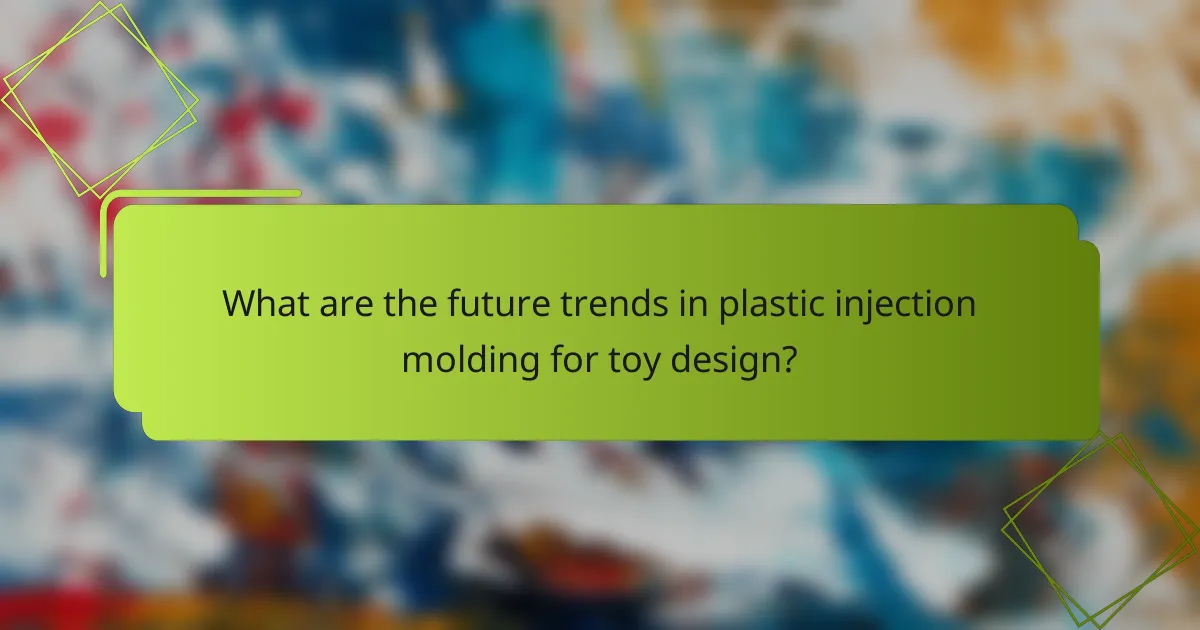
What are the future trends in plastic injection molding for toy design?
Future trends in plastic injection molding for toy design include increased use of sustainable materials. Companies are focusing on biodegradable plastics to reduce environmental impact. Advanced manufacturing technologies are enhancing precision and efficiency. This includes the integration of automation and robotics in production lines. Customization options are expanding, allowing for unique designs tailored to consumer preferences. Smart toys are being developed with embedded technology, enhancing interactivity. The trend towards smaller production runs is rising, enabling rapid prototyping and quicker market entry. These trends reflect the industry’s adaptation to consumer demands and environmental considerations.
How might emerging technologies reshape toy design and production?
Emerging technologies will significantly reshape toy design and production. Innovations like 3D printing allow for rapid prototyping and customization of toys. This technology enables designers to create intricate shapes and designs that were previously impossible. Additionally, augmented reality (AR) can enhance play experiences by integrating digital elements into physical toys. Robotics in manufacturing can streamline production processes, reducing costs and time. Advanced materials, such as biodegradable plastics, are becoming more prevalent, promoting sustainability in toy production. Data analytics can inform designers about consumer preferences, leading to more targeted and appealing products. These technologies collectively drive innovation and efficiency in the toy industry.
What potential impact do 3D printing and bioplastics have on the industry?
3D printing and bioplastics have the potential to revolutionize the toy industry. They enable rapid prototyping and customization of toy designs. This technology reduces production time and costs significantly. Bioplastics offer a sustainable alternative to traditional plastics. They are derived from renewable resources and can be biodegradable. The use of bioplastics can decrease the environmental impact of toy manufacturing. Studies show that 3D printing can reduce material waste by up to 90%. These innovations are driving a shift towards more eco-friendly practices in the industry.
How can manufacturers adapt to changing consumer preferences in toy design?
Manufacturers can adapt to changing consumer preferences in toy design by conducting regular market research. This research identifies trends and preferences among consumers. They can also engage with their target audience through surveys and focus groups. Feedback from consumers helps manufacturers understand what features are desirable. Additionally, incorporating sustainable materials can appeal to environmentally conscious buyers. Adapting to technological advancements, such as integrating smart features, can attract tech-savvy consumers. Furthermore, offering customizable options allows consumers to personalize their toys. By staying responsive to these factors, manufacturers can remain competitive in the evolving toy market.
What best practices should manufacturers follow in plastic injection molding for toys?
Manufacturers should follow several best practices in plastic injection molding for toys. First, they must ensure that materials used are non-toxic and safe for children. Compliance with safety standards like ASTM F963 is crucial. Second, manufacturers should conduct thorough mold design and testing. This minimizes defects and ensures consistent quality. Third, precise temperature control during the injection process is essential. This helps achieve optimal material flow and reduces warping. Fourth, regular maintenance of injection molding machines is necessary. Well-maintained machines operate efficiently and produce better quality toys. Fifth, manufacturers should implement quality control measures. Regular inspections during production can catch issues early. Finally, they should stay updated on industry trends and technologies. This allows for innovation and improved production techniques.
How can quality control be effectively implemented in the injection molding process?
Quality control in the injection molding process can be effectively implemented through systematic monitoring and testing. This includes establishing clear quality standards for materials and finished products. Regular inspections during production help identify defects early. Utilizing statistical process control (SPC) techniques can track variations in the manufacturing process. Implementing automated inspection systems enhances accuracy and consistency. Training operators on quality standards ensures adherence to best practices. Data collection for analysis aids in continuous improvement efforts. These methods collectively contribute to reducing defects and enhancing product quality in injection molding.
What strategies can be used to optimize production efficiency and reduce costs?
Implementing lean manufacturing principles optimizes production efficiency and reduces costs. Lean manufacturing minimizes waste while maximizing productivity. Techniques include streamlining processes, reducing cycle times, and improving quality control. Automation can enhance precision and speed, further driving down costs. Regular employee training fosters skill development and efficiency. Utilizing data analytics identifies bottlenecks and areas for improvement. Collaborating with suppliers can lead to cost savings through bulk purchasing and better materials management. These strategies collectively lead to a more efficient production process and significant cost reductions.
The main entity of this article is plastic injection molding, specifically its evolution in the context of toy design. The article examines the historical development of plastic injection molding from the 1930s to the present, highlighting key milestones, technological advancements, and the impact of market demands on toy production methods. It discusses the initial materials and techniques used, the significance of innovations like CAD and automation, and the growing emphasis on sustainability in manufacturing processes. Furthermore, the article explores future trends and best practices that manufacturers should adopt to enhance efficiency, safety, and environmental responsibility in toy design.
